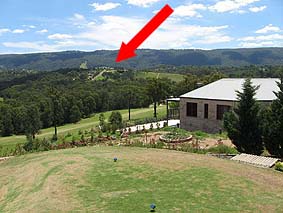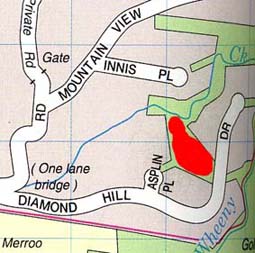|
By Les and Anne Dollin
In the Age of the Dinosaurs 200 million years ago, over 90 volcanoes erupted in the Sydney Basin! The molten rock and volcanic gases exploded through the layers of coal, sandstone and shale underneath the ground. (These layers of rock had been laid down in a fascinating series of events during the geological history of the Sydney Basin.)
One of these volcanoes was at Kurrajong, NSW. Known today as 'Diamond Hill', this low grassy hilltop is only three km from Kurrajong, between Comleroy Road and the mountains.
 |
 |
| Left: Diamond Hill is a low grassy hill between Comleroy Road and the Blue Mountains -- seen here with the Kurrajong Hills Golf Course on Peel Parade in the foreground. Right: A map showing the approximate location of the remaining volcanic rock at Diamond Hill in red. |
Fortunately for today's residents, this volcano has been extinct for 200 million years but when it was active, Diamond Hill would have been a pretty dramatic place to be!
Volcanoes of this type are called 'diatremes'. Molten rock forced its way up from deep underground and hit a swampy area. The 1000 oC molten rock superheated the water, resulting in a massive explosion that blasted out a wide cone of the surrounding sandstone and shale rock! The fragmented rock eventually compacted back down into the crater, forming a rock called 'breccia'. Later more molten rock forced its way up through the breccia, filling part of the crater. This flow of molten rock cooled into a hard black rock called 'basalt'.
Today all that can be seen of the volcanic diatreme at Diamond Hill is a low grassy hill. The top part of the volcano has been completely eroded away. However, under the ground is a 300 m wide cone-shaped plug of breccia and basalt rock -- the remains of Kurrajong's volcano.
Diamonds in Diamond Hill?
Diamond Hill got its name when a local resident, Mr Bill Bell, claimed he found a diamond in this area.
As well as producing deposits of breccia and basalt, volcanic diatremes may also bring diamonds and gemstones to the surface from deep underground. Most diamonds were formed about 1 - 3 billion years ago, under extreme pressure about 200 km under the ground. They sometimes get caught up in the volcanic material being blasted out of a diatreme to await discovery by local fossickers.
A Blue Metal Quarry in Kurrajong?
Mining companies saw Diamond Hill as a potential quarry site and a series of companies studied the site to see how much breccia and basalt might be extracted:
-- Farley and Lewers: 1968, 1974, 1976
-- Hannes Walpole: 1972
-- Pioneer Concrete: 1973
-- Mosaic Tile and Pottery Co Pty Ltd: 1976
-- Kurrajong Aggregates: 1977
Farley and Lewers and Mosaic Tile and Pottery each applied to Colo Shire Council for approval to establish a hard rock quarry at Diamond Hill. Both applications were rejected by the council, and appeals, even as high as the Supreme Court, were also refused. The Colo Shire Council spent thousands of dollars dealing with these applications and appeals.
Finally Kurrajong Aggregates submitted their mining application in November, 1977. Once again the Colo Shire Council rejected the application. Then in 1978, Mr Paul Landa, NSW Minister for Planning and Environment, initiated a full scale Inquiry by the State Pollution Control Commission to settle the matter.
Kurrajong Aggregates proposed to mine basalt and breccia rock at Diamond Hill down to 50 m below the level of the adjoining Blue Gum Creek. However, Kurrajong Aggregates suggested that the deposit might even extend to 150 m below the level of Blue Gum Creek. The development was to include a crushing plant, settling ponds, aggregate stockpiles and access roads.
They expected that blasting would only be done once a week but added that daily blasting might be necessary. The quarry was to last about 10 to 15 years and be run from 7am to 5pm, five days a week. About every three minutes, heavy trucks were to travel back and forth via Mill Road picking up deliveries of the crushed rock.
Not surprisingly the local residents were quite alarmed by these proposals. They formed the 'Kurrajong Hills Committee' to fight the application and hired consultants to support their cause. According to the Windsor and Richmond Gazette (6 Dec 1978), a procession of twenty riders and horse drawn vehicles marched on Parliament House in Macquarie Street, Sydney, with about 200 supporters to deliver a petition to the Premier, Mr Wran. Their message of 'Don't mine Kurrajong' came across loud and clear.
They also gathered at the Grose Vale Community Centre for the opening of the State Pollution Control Commission Inquiry on 11 December, 1978 with their signs: 'Must we grovel to gravel?', 'Don't oppose us with dozers!' and 'If they mine that quarry, we'll all be sorry!' More than 200 submissions were sent in to the Inquiry, none actively in favour of the quarry.
Kurrajong Aggregates expected to extract ten million tonnes of first quality aggregate and road base from the Diamond Hill quarry. Other consultants disputed the quality of the material and also the quantity, estimating that only about 6 million tonnes could really be extracted.
The company had proposed to rehabilitate the site, when the quarry was finally exhausted, by turning the deep hole with its surrounding towering rock walls into a lake or a parkland for public recreation.
At the end of the day the community and the council won the battle. The State Pollution Control Commission Inquiry recommended that the application should be refused and that the land should be rezoned to prohibit any extraction of hard rock or other materials
What in impact it would have had on the peaceful Kurrajong area had this development been allowed to proceed.
Further Reading:
Diamond Hill Inquiry. Report and findings of the environmental inquiry into a proposed extractive industry at Diamond Hill, Kurrajong. State Pollution Control Commission. 23 February 1979.
|
|
|

